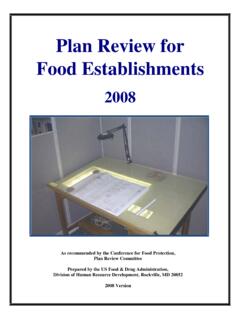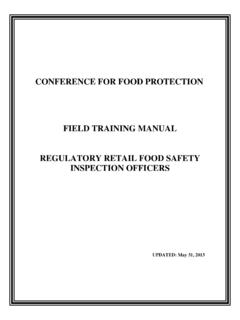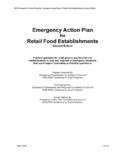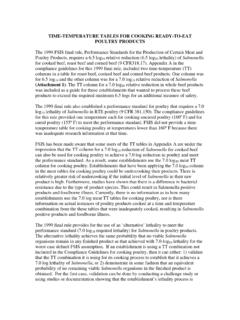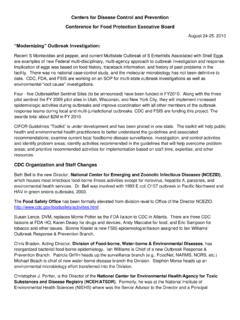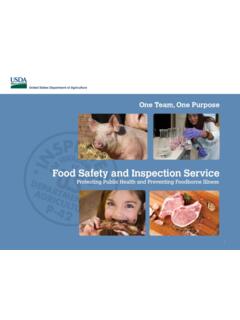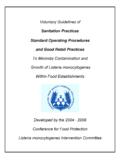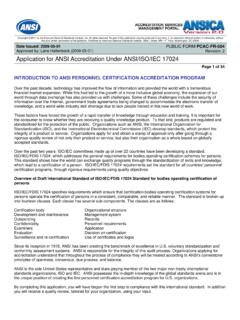Transcription of for Food Recovery Programs - Food Protect
1 Comprehensive Guidelines for food Recovery Programs ** Developed by the food Recovery Committee 2000 Conference for food Protection / Council I FINAL October 3, 2000 Updated January 2004 Updated April 2006 Updated March 2007. TABLE of CONTENTS About These Guidelines .. 2 Definitions .. 3 Introduction to food 6 food Recovery Activities .. 6 Legal 9 Implementing a food Recovery Program .. 10 food Safety Procedures .. 12 food Rescue Program Responsibilities .. 33 Guidelines for Monitoring Programs .. 34 Handling Donations of Game Animals .. 34 Planning for food 38 Preventive or Mitigation Strategies:.. 39 APPENDIX A .. 43 Guidance Charts for Assessment of food on Receipt.
2 43 APPENDIX B .. 47 Forms to Simplify Record 47 APPENDIX C .. 61 Forms for Reporting food Worker or Volunteer Illness or Symptoms .. 61 APPENDIX D .. 78 Emergency Point of Contact:.. 78 REFERENCES .. 80 Publications .. 80 Web Sites .. 80 food Defense 80. 1 About These Guidelines Over the years, various inquires received from regulators and others about safe food management and preparation practices in food Recovery operations prompted the United States Department of Agriculture (USDA) and food and Drug Administration (FDA) to enter into a joint project in 1997 1998 to develop guidelines for food Recovery Programs . The resulting document was presented to the 1998 Conference for food Protection (CFP) for acceptance by Conference stakeholders (industry, consumers, academia, and federal/state/local food safety regulators).
3 Under the auspices of Council l (its laws and regulations advisory group ), the 1998 CFP formed a food Recovery Committee to work with FDA and USDA to fully develop the food Recovery guidelines. The CFP food Recovery Committee is composed of members of the retail and food service industry, hunger relief organizations, and federal, State, and local regulatory agencies. The CFP food Recovery Committee used the USDA/FDA guideline and documents from America's Second harvest as a base and this comprehensive guideline is the result of the Committee's efforts to fulfill its charge. Upon acceptance by the 2000 CFP, the guideline was proposed to become an annex to the FDA food Code.
4 A short description of the Guidelines can be found in the 2005 FDA food Code in Annex 2, References, under 3. Supporting Documents, M. Comprehensive Guidelines for food Recovery Programs , . 2 Definitions Active Managerial Control means the purposeful incorporation of specific actions or procedures by industry management into the operation of their business to attain control over foodborne illness risk factors. Approved Source means an acceptable supplier to the regulatory authority based on a determination of conformity with principles, practices, and generally recognized standards that Protect public health. Critical Control Point means a point or procedure in a specific food system where loss of control may result in an unacceptable health risk.
5 Excess food means any extra wholesome, edible food , including food that was prepared for service, but not served or sold. Field gleaning (gleaning) means the collection of crops from fields that have already been mechanically harvested or on fields where it is not economically profitable to harvest . food defense is the collective term used by the food and Drug Administration (FDA), United States Department of Agriculture (USDA), Department of Homeland Security (DHS), etc, to encompass activities associated with protecting the nation's food supply from deliberate or intentional acts of contamination or tampering. This term encompasses other similar verbiage ( , bioterrorism,(BT), counter terrorism (CT) etc.)
6 food Distribution Organization (FDO) means the organization that accepts donated food and directly distributes it to needy consumers or, in some cases, distributes donated food to another facility (receiving facility) which will then directly distribute it to the consumer. This FDO and the receiving facility may be one and the same. food Recovery means the collection of wholesome food for distribution to people in need sometimes referred to as food rescue. HACCP is an acronym that stands for Hazard Analysis and Critical Control Point, a prevention based food safety management system. HACCP systems are designed to prevent the occurrence of potential food safety problems.
7 HACCP Plan means a written document that delineates the formal procedures for following the Hazard Analysis Critical Control Point principles developed by the National Advisory Committee on Microbiological Criteria for Foods. Hazard means a biological, chemical, or physical property that may cause an unacceptable consumer health risk. Perishable food meats, dairy products, produce, and bakery items that are donated 3 from grocery stores, produce distributors, food distributors, etc. Prepared foods are foods of all descriptions that have been prepared but were never served. This includes cooked items, such as meats, entrees, vegetables, starches, deli trays, and vegetable trays, for example.
8 Potentially Hazardous food (Time/Temperature Control for Safety (TCS) food ). (1) "Potentially hazardous food (time/temperature control for safety (TCS) food )" means a food that requires time/temperature control for safety (TCS) to limit pathogenic microorganism growth or toxin formation. Most, but not all perishable food and prepared foods are PHF/TCS food . (2) "Potentially hazardous food (time/temperature control for safety (TCS) food )" includes: (a) An animal food that is raw or heat treated a plant food that is heat treated or consists of raw seed sprouts, cut melons, or garlic in oil mixtures that are not modified in a way that results in mixtures that do not support pathogenic microorganism growth or toxin formation and (b) Except as specified in Subparagraph (3)(d) of this definition, a food that because of the interaction of its water activity (AW) and PH values is designated as product Assessment Required (PA) in Tables A and B from the FDA food Code and provided at the end of the food Safety Procedures section.
9 1 (3) "Potentially hazardous food (time/temperature control for safety food )" does not include: (a) An air cooled hard boiled EGG with shell intact, or an EGG with shell intact that is not hard boiled, but has been pasteurized to destroy all viable salmonellae (b) A food in an unopened HERMETICALLY SEALED CONTAINER that is commercially processed to achieve and maintain commercial sterility under conditions of non refrigerated storage and distribution (c) A food that because of its PH or AW value, or interaction of AW and PH values, is designated as a non PHF/non TCS food in Table A or B of this definition 1 As referenced in the 2005 food Code, Paragraph 1 (B)
10 Definition of Potentially Hazardous food (Time/Temperature Control for Safety food 2005. Department of Health and Human Services, Public Health Service, food and Drug Administration. 2005. Available at ~dms/fc05 4 (d) A food that is designated as product Assessment Required (PA) in Table A or B of the food Code definition and has undergone a product Assessment showing that the growth or toxin formation of pathogenic microorganisms that are reasonably likely to occur in that food Is precluded due to: (i) Intrinsic factors including added or natural characteristics of the food such as preservatives, antimicrobials, humectants, acidulants, or nutrients, (ii) Extrinsic factors including environmental or operational factors that affect the food such as packaging, modified atmosphere such as REDUCED OXYGEN PACKAGING, shelf life and use, or temperature range of storage and use, or (iii) A combination of intrinsic and extrinsic factors or (e) A food that does not support the growth or toxin formation of pathogenic microorganisms in accordance with one of the Subparagraphs (3)(a) (3)(d))
